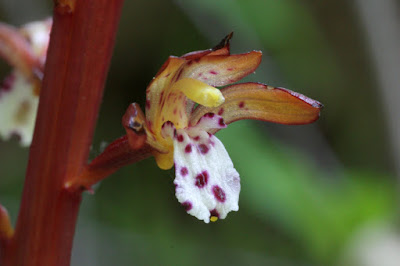The Fifth orchid we've found in bloom this season is Corallorhiza mertensiana, known as the Western or Merten's Coralroot. This species is variable in color, the stems ranging from white, through yellow, pink and tan to purple. The location where we first found it in bloom has the darkest color forms we've ever found, a deep reddish-purple, and has only that color form. The other location we visited has every color form imaginable except this dark-colored form. The other location has every color form imaginable, but they were just starting to bloom there. At the second location only the darker color forms were starting to bloom, but I took one photo of the stems of a lighter color form, Corallorhiza mertensiana fma. pallida. This species is often a challenge to photograph since it tends to grow on dark forest floors and if there is even a hint of a breeze, it is hard to get a good focus and exposure.
Corallorhiza mertensiana
Corallorhiza mertensiana fma pallida
Along with this Coralroot we found a lot of the Western Spotted Coralroot, Corallorhiza maculata var. occidentalis in bloom. They are at the peak of their season or just past it and in one of the locations we visited we photographed again the several spikes of the golden-stemmed form of this species, fma. aurea. There were also a number of plants of the red-stemmed form, fma. punicea. This is another species that we'll be seeing well into summer at higher elevations. At another location we found some of the brown-stemmed form, fma. intermedia.
Corallorhiza maculata var. occidentalis fma. punicea
Corallorhiza maculata var. occidentalis fma. intermedia
The Fairy Slippers, Calypso bulbosa var. occidentalis, are nearly finished at lower elevations, many of the remaining flowers fading to an off-white, or withering at the end of developing seed pods or gone altogether. They will, however, be starting to bloom at higher elevations and we should be seeing them well into June. In fact, we'll be visiting some of those locations in a few weeks. That's one of the advantages of living near the mountains - the flowering season of many plants including many of the native orchids is extended.Corallorhiza maculata var. occidentalis fma. intermedia
Washington has four species of Coralroots and three of the four are featured in this post. The only not featured is Corallorhiza trifida, the Early Coralroot. We saw a few more of the Striped Coralroot, but there were only a few stems. It is difficult to know whether they are just very sparse this year or whether they are blooming at their usual time in spite of an early spring, with more of them coming later. The few I saw were in full bloom and I found no sign of more, but I did not spend a lot of time looking either.
Corallorhiza striata var. striata
We also revisited the low-elevation site of the Heart-leaved Twayblade, Listera or Neottia cordata var. nephrophylla fma. rubescens in order to get some better photos and to give my wife the chance to see them - she had not been along when I photographed them the first time. They were still in good form and we were able to get better photos, though this is a species we'll be seeing in different places for many weeks, especially at higher elevations. We'll see, too, its green form, which is actually more common than the red form shown here.
Calypso bulbosa var. occidentalis
%2B%2330.JPG)
%2B%2329.JPG)
%2B%2328.JPG)



%2B%2398.JPG)
%2B%23103.JPG)
























%2B%2337.JPG)
%2B%2340.JPG)

No comments:
Post a Comment